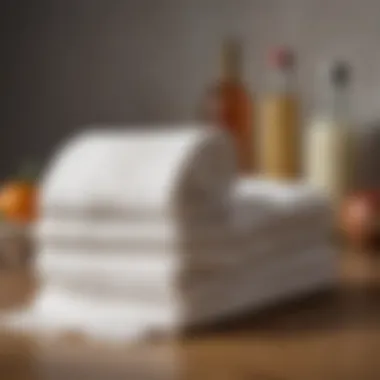A Comprehensive Guide to Unpaper Towels


Intro
As more individuals and households search for sustainable alternatives in their daily routines, a particular item has captured attention: unpaper towels. These reusable alternatives are gaining traction, primarily due to the growing awareness of their environmental benefits and practical usage in the kitchen. While traditional paper towels are single-use and often find themselves discarded after just one job, unpaper towels offer a much more eco-friendly approach.
Imagine opening your kitchen cabinet and finding a stack of soft, absorbent cloths ready to tackle spills, clean surfaces, and more, all while significantly lowering your ecological footprint. It's no wonder that meal prep enthusiasts and eco-conscious chefs alike are gravitating towards these cloth wonders.
Throughout this article, we will peel back the layers to explore what makes unpaper towels an invaluable addition to the culinary landscape. We will discuss their myriad advantages over conventional paper towels, their broader environmental impact, along with practical tips to ensure optimal usage and maintenance. The market is brimming with choices, so we will also delve into brand recommendations to help guide your selection.
The shift towards using unpaper towels isn’t merely a passing trend; it is part of a larger movement advocating for sustainability in our kitchens and our lives. By the completion of this article, you should feel well-equipped to enhance your culinary experience with these elegant yet practical cloths, transforming how you approach everyday tasks while also doing your part for the planet.
Understanding Unpaper Towels
When we think about our daily lives, it’s often the small things that leave a lasting impact. One of these unassuming items is the humble paper towel. However, as we lurch forward in an era steeped in environmental consciousness, alternatives like unpaper towels beckon for our attention. Understanding unpaper towels isn't merely about grasping their definition; it’s a step toward a more sustainable lifestyle.
Definition of Unpaper Towels
So, what exactly are unpaper towels? To put it plainly, unpaper towels are reusable cloth alternatives designed to replace disposable paper towels. Made from cotton, flannel, or even bamboo, they offer a softer, more durable option for various household tasks. The appeal lies not just in their functionality but also in their longevity. Typically, these towels come in rolls that mimic the traditional paper towel roll, making them user-friendly. Think of them as a cross between a kitchen towel and a napkin, fitted neatly into a holder and ready to tackle spills or messes at a moment's notice.
Unlike their single-use counterparts, unpaper towels can be washed and reused multiple times, leading to significant waste reduction over time. It’s much like having your cake and eating it too—you gain the advantage of convenience while making a conscious choice for the planet.
Comparison with Traditional Paper Towels
Traditionally, paper towels have been the go-to for cleaning, mopping up spills, and drying hands. But there’s a stark contrast when placing them side-by-side with unpaper towels.
- Environmental Considerations:
Traditional paper towels contribute massively to deforestation and waste. Think about it: thousands of trees could be saved each year if households made the switch to fabric options. Unpaper towels, on the other hand, push back against this trend, promoting sustainability by leveraging materials that require less energy and resources to produce. - Cost Efficiency:
Yes, those individuals who run the math will agree that switching to unpaper towels could save money in the long run. Sure, there’s an upfront cost to buying unpaper towels—usually a little pricier than a roll of paper towels—but the savings accumulate over time since they can be washed and reused. - Effectiveness:
In terms of sheer absorption and durability, unpaper towels often outperform traditional ones. A soaked mess might spell disaster for a flimsy paper towel, but a set of well-stitched unpaper towels can tackle the job with grace and ease. Moreover, they come in various colors and patterns, adding a spark of personality to your kitchen towels.
In summary, while traditional paper towels hold their place in many households, the emergence of unpaper towels presents a compelling alternative that is hard to overlook. The shift doesn’t merely replace one item with another; it represents a transformative way of thinking about waste, resources, and sustainability.
The Environmental Impact
Understanding the environmental impact of unpaper towels is pivotal in recognizing their role in sustainable living. Traditional paper towels contribute significantly to deforestation, water waste, and landfill overflow. In contrast, unpaper towels, crafted from reusable materials such as cloth or bamboo, present not only an eco-friendly alternative but also a practical solution for reducing waste and conserving resources. This section dives deep into two critical facets of environmental sustainability that these alternatives promote: material sustainability and waste reduction.
Material Sustainability
When considering unpaper towels, one of the standout features is their commitment to material sustainability. Unlike conventional towels, which typically rely on virgin trees cut down specifically for this purpose, unpaper towels often utilize recycled or renewable materials. For example, many brands produce unpaper towels from 100% cotton, which possesses the dual benefit of biodegradability and reusability. The cultivation of cotton, especially organic varieties, can minimize the harmful effects of pesticides and contributes to healthier soil.
Furthermore, the use of bamboo has gained traction recently. Bamboo is a fast-growing grass that requires little water and no pesticides to flourish, making it a champion of sustainable materials.
In terms of durability, unpaper towels can endure hundreds of wash cycles without degrading, vastly outlasting their paper counterparts. This longevity not only saves money in the long run but also lessens the need for constant replacements, fostering a culture of mindful consumption. In essence, when you opt for unpaper towels, you're not only reducing your ecological footprint but also playing a part in a much larger movement toward a sustainable future.
Reduction of Waste
Waste reduction is another cornerstone of the environmental argument for unpaper towels. Traditional paper towels are a one-time-use item that, once soiled, heads straight for the landfill. In contrast, unpaper towels are designed to be used multiple times, drastically cutting down the volume of waste generated in a typical kitchen setting. It's estimated that the average household disposes of several thousand paper towels each year. By switching to cloth alternatives, one can potentially divert these materials from overcrowded landfills.
Moreover, the impact does not end with the household. The production process of paper towels is energy-intensive and resource-heavy. The extraction of trees, processing, and shipping adds a significant carbon footprint to every roll sold.
"Opting for unpaper towels isn't just a small choice; it's a ripple in the vast ocean of consumer habits that can lead to considerable ecological restoration."
By reducing dependency on disposable products, consumers foster a more sustainable lifecycle that benefits the planet. Little changes, when multiplied across many households, can lead to substantial results in reducing national waste levels. Ultimately, unpaper towels serve as a tangible reminder of how simple choices can hugely impact the environment, paving the way for a more sustainable lifestyle.
Economic Considerations
In the ever-evolving world of kitchen tools, unpaper towels stand out not just for their environmental benefits but also for the economic sense they make. Understanding the financial implications of switching to these reusable cloth alternatives is crucial for making an informed decision. Many readers might initially be swayed by the cost of traditional paper towels, often overlooking the long-term savings that unpaper towels can offer. Let’s break this down further.
Cost-Effectiveness Over Time
On the surface, unpaper towels may seem more expensive upfront. However, a deeper dive into the math reveals a different story.


- Purchase Price: An initial investment in a quality set of unpaper towels might range anywhere from $20 to $50, depending on the brand and the number of towels included. While this might feel like a pinch, consider this against the recurring costs of paper towels.
- Usage: If a household typically uses a roll of paper towels each week, that can add up to around $15 or more each month. Over a year, this leads to an expense of approximately $180.
- Lifespan: A well-taken-care-of unpaper towel can last for years. If one buys a set of unpaper towels for, say $30, and they endure for four years, that’s just about $7.50 per year. In this scenario, the savings become evident.
In essence, despite the initial sticker shock, unpaper towels are a great investment when looking at the bigger picture.
Initial Investment vs. Long-Term Savings
Looking at unpaper towels purely through the lens of their initial price tags can be misleading. Here’s how their long-term savings potential stacks up:
"It’s not about what you spend today, but about how much you’ll save tomorrow."
- Upfront Cost: Investing in unpaper towels is akin to buying a reusable coffee cup. You might pay more upfront, but over time, the cost per use drops significantly.
- Replacement Frequency: Unlike paper towels that need constant replenishment, unpaper towels can be washed and reused countless times. Depending on usage frequency, one might easily see them replacing the need for dozens of rolls of paper towels over a year.
- Environmental Considerations: It cannot be ignored that using unpaper towels also cuts down on spending associated with garbage disposal and recycling related to the waste created by paper towels.
- Overall Savings: Consider committing to an initial outlay for unpaper towels not just as a financial decision but also as a step towards sustainable living; it blends cost-effectiveness with an eco-focused philosophy.
In a nutshell, while the financial commitment at first glance might deter some, it’s essential to weigh that against potential savings over time. This brings us to an overall evaluation: once an individual adopts this switch, their wallets and the planet stand to gain.
Practical Uses in the Kitchen
When it comes to unpaper towels, their role in the kitchen is paramount. These eco-friendly alternatives to traditional paper towels not only bring a sense of sustainability to the cooking space but also serve a multitude of practical applications. Using unpaper towels can make daily chores easier, cleaner, and more efficient, which ultimately enhances your culinary experience. With the right approaches, they can become a versatile tool in your kitchen arsenal, performing tasks that go beyond simply soaking up spills.
Everyday Cleaning Tasks
Unpaper towels, often made from cotton or bamboo, can be a game-changer when it comes to everyday cleaning. Unlike disposable paper towels that end up in landfills, unpaper alternatives can be washed and reused time and time again, making them an investment that pays off in both savings and sustainability.
- Wiping Surfaces: Use unpaper towels to wipe down countertops and tables. They are durable and can handle a range of messes, from crumbs to spills, without tearing.
- Cleaning Windows: Just like that old rag you might reach for, these towels can be dampened and used to clean mirrors and glass surfaces, leaving them streak-free.
- Dusting and Polishing: These towels are great for dusting as they trap dust rather than push it around. They can be dampened with a bit of water or vinegar for polishing furniture as well.
In essence, unpaper towels lend themselves well to various everyday cleaning tasks. Their absorbency and toughness make them favored in households that value cleanliness and sustainability.
Food Preparation Applications
When it comes to food preparation, unpaper towels can provide both functionality and efficiency. With cooking often involving mess, having a reliable tool at hand is essential for maintaining a streamlined process.
- Drying Fresh Produce: After washing fruits and vegetables, unpaper towels can be used to dry them off quickly. Their absorbent nature ensures that you won’t end up with water pooling on your counter.
- Covering Bowls: If you’re letting dough rise or need to cover a bowl of leftovers, unpaper towels can serve as a breathable cover, allowing both air and moisture to pass through without trapping too much condensation.
- Wiping Hands: Cooking often leads to messy hands, and unpaper towels can be a quick solution for wiping during food prep, allowing for a seamless cooking experience without the guilt of using single-use products.
Key Takeaway: Embracing unpaper towels in your kitchen can reduce waste and help manage mess, proving they are more than just a replacement for traditional towels.
Popular Brands Reviewed
When venturing into the world of unpaper towels, the myriad of options can be overwhelming. This section tackles the popular brands that have made a name for themselves in this eco-friendly niche. Each brand offers unique features that can cater to various consumer needs. Understanding these brands sounds simple, but it has value beyond mere product comparison. It also aids in aligning personal values with thoughtful purchasing decisions.
Moreover, choosing the right brand is pivotal for achieving the desired balance between sustainability and functionality. Each unpaper towel brand typically has its strengths and weaknesses; therefore, being well-informed about options enriches the decision-making process in this expanding market.
Brand A - Features and Benefits
Brand A stands out with its absorbent, durable material that mimics traditional paper towels but without the one-time-use downside.
Some highlights include:
- Reusability: These towels can withstand multiple washes, making them economical in the long-run.
- Available Prints: Fun designs add a personal touch to the kitchen, appealing to those who value aesthetics.
- Biodegradable Options: The company’s commitment to sustainable practices resonates with environmentally conscious consumers.
Users often praise Brand A's balance between effectiveness and eco-friendliness, positioning it as an ideal option for those serious about making a change in their cleaning habits.
Brand B - Features and Benefits
Brand B positions itself as a frontrunner for families looking to incorporate unpaper towels without compromising on quality.
Key features include:
- Softness: Made from cotton, these towels are soft on skin, making them suitable for family use.
- Color Choices: They come in multiple colors, giving an option to match kitchen decor.
- Quick-drying: The towels dry quickly, preventing any funky smells usually associated with damp fabrics.


Brand B’s focus on user experience and family needs places it as a top contender for households aiming at sustainability without the hassle.
Brand - Features and Benefits
Brand C, a more minimalist brand, emphasizes functionality paired with eco-consciousness.
Key selling points are:
- High Absorbency: Designed to absorb more liquid than traditional paper towels.
- Simple Designs: They market no frills; their towels are plain and effective for those who prefer a low-key approach.
- Affordable Pricing: Competitive pricing ensures wider accessibility, allowing more people to switch to unpaper options.
Many users appreciate Brand C's straightforward approach, making it a preferred option especially for those new to unpaper towels.
These three brands represent just a slice of the burgeoning market, but their distinct advantages help customers make informed choices when it comes to transitioning from conventional to unpaper towels.
Selecting the Right Unpaper Towel
Choosing the right unpaper towel is pivotal. It can significantly impact your experience, making everyday cleaning tasks a breeze or a nuisance. This section explores specific elements, benefits, and considerations for selecting the right unpaper towel. By understanding these factors, you not only enhance functionality in your kitchen but also align with your commitment to sustainability.
Factors to Consider
When scrolling through various unpaper towel options, it's essential to keep an eye out for a few key features. Here are some parameters to guide you in making an informed choice:
- Absorbency: The degree to which a towel can soak up moisture is crucial. An effective unpaper towel should be able to handle spills without leaving you high and dry.
- Durability: Look for materials that can withstand multiple washes without losing their form. Knowing that the towel can endure scrubbing and soaking gives peace of mind.
- Softness: When cleaning delicate surfaces or using them around food, softness matters. You don't want to create scratches on your favorite dinnerware.
- Size: Depending on your use, size could either be a boon or a bane. Larger towels can cover bigger spills, while smaller ones might be more handy for prep tasks.
- Ease of Cleaning: Consider how easy it is to wash the towels. Some can just be tossed in the washing machine, while others may require special care.
Material Types and Their Properties
Understanding the material of unpaper towels is integral to selecting the right one. Here's a rundown of popular materials and what they bring to the table:
- Cotton: Highly absorbent and soft, cotton unpaper towels are a strong contender. They feel comfortable and are versatile for various tasks, from drying dishes to wiping counters.
- Bamboo: Eco-friendliness is the highlight of bamboo towels. They have natural antibacterial properties, making them great for kitchen use. Plus, bamboo is renewable, giving it a thumbs up in the sustainability department.
- Microfiber: Known for their excellent cleaning prowess, microfiber towels trap dirt and dust efficiently. They’re perfect for stubborn grime but can collect odors if not washed regularly.
- Flannel: Flannel towels offer softness and high absorbency. Their thick texture feels nice on surfaces and can hold considerable amounts of liquid, making them ideal for various cleaning tasks.
"The right unpaper towel can turn frustration into satisfaction, providing not just a product but a cleaner way to manage your kitchen."
Before making a final decision, think about these factors and materials in relation to your lifestyle. Choosing the right unpaper towel means harmonizing your cleaning needs with environmental responsibility.
Maintenance and Care
Taking care of unpaper towels is crucial to ensure their longevity and hygienic use. Much like any kitchen tool or accessory, how well you maintain them directly impacts their effectiveness and your overall satisfaction with the product. Proper maintenance can not only maximize their lifespan but also preserve their softness and absorbency, allowing them to perform their tasks efficiently.
Washing and Drying Techniques
Cleaning unpaper towels is quite straightforward, yet there are some techniques that can make a difference. Firstly, it’s advisable to wash them before their initial use. This helps in removing any residues from the manufacturing process and can enhance their absorbency.
When laundry day rolls around, opt for a gentle cycle with cold or lukewarm water. Using hot water can break down the fibers over time, so sticking to colder temperatures is a wise choice. Adding in a mild detergent is usually enough, but avoiding fabric softeners is key. These products can create a coating that reduces absorbency.
To dry your unpaper towels, the air-dry method is often recommended. Hanging them to dry can maintain their shape better and help prolong their lifespan. If you choose to tumble dry, opt for a low heat setting to prevent damaging the fibers. I’d suggest skipping the dryer sheets as well; it’s like throwing a wrench in the works for those soft fibers!
Longevity and Replacement Tips
While unpaper towels are designed to be durable, they won’t last forever. Here are some pointers to maximize their lifespan and know when it’s time for a change.
- Regular Inspection: Keep an eye out for signs of wear, such as thinning areas or fraying edges. If they start showing wear and tear, it may be time to consider replacing them.
- Avoiding High-Stress Situations: Use unpaper towels for tasks they are suited for; heavy scrubbing or dealing with sharp objects can lead to premature wear.
- Rotational Use: If you have multiple sets, rotate among them to allow time for each towel to rest and recover after washing.
- Know the Material: Different materials have varying lifespans. For example, the cotton towels may show signs of use sooner than those made from more durable materials like bamboo.
Consumer Feedback and Experiences
Understanding the landscape of consumer feedback and experiences is crucial when navigating the realm of unpaper towels. Being a part of the sustainable movement, unpaper towels promise eco-friendliness and effective functionality, but what really matters is how they perform in real kitchens. It's not just about slick marketing and glowing claims; the lived experiences of users paint a true picture of these products. Catering to food lovers of all ages, the depth of insights gathered from consumers can illuminate the pros and cons, offering valuable guidance for potential buyers.
User reviews often reveal unexpected uses for these versatile towels beyond basic kitchen tasks. Additionally, testimonials lend credence to the concept that products can genuinely enhance everyday life while supporting sustainable practices. One thing to note is that consumers might express nuanced opinions influenced by personal preferences, lifestyle changes, and even local cleaning habits. These factors can collectively inform the decision-making process, fostering a communal understanding of what works best with unpaper towels.


"I never thought I would give up paper towels until I tried unpaper towels. They're not just a substitute; they redefine how I clean my kitchen!"
User Reviews and Testimonials
Customer testimonials can provide rich understanding of what to expect from unpaper towels. Many users often discuss qualities such as absorbency, durability, and ease of cleaning. Comments may highlight specific features like lint-free surfaces or the ability to withstand harsh cleaning solutions without falling apart. Whether someone appreciates the softness of a cotton-based unpaper towel or values the quick-dry nature of bamboo varieties can heavily influence that user's loyalty to a particular brand.
Moreover, positive reviews typically focus on how these towels have helped in reducing paper waste, aligning with consumers' goals for more sustainable living. Conversely, any negative feedback could revolve around concerns like initial cost, or performance issues when used for heavier-duty tasks.
Consider the following points from user feedback when evaluating different unpaper towels:
- Absorbency levels: Are certain brands more effective at soaking up spills?
- Ease of maintenance: How do users feel about washing and drying these towels?
- Versatility: What multiple uses are consumers finding for these towels?
Common Issues and Solutions
As with any product, unpaper towels come with their own set of challenges. Consumers often report issues like staining or odors if the towels are not managed properly. A common concern is about the durability of fabrics post-wash, with some noticing degradation in performance over time. Fortunately, many of these problems have workable solutions.
Here are some tips on common issues and their corresponding resolutions:
- Stains: To combat stains, soak the unpaper towel in vinegar and water solution before laundering.
- Odors: A regular wash with a dash of baking soda can eliminate unwanted smells.
- Durability: Following the manufacturer’s washing guidelines helps retain fabric integrity.
- Fading: Hang dry to maintain color vibrancy instead of using a dryer.
In wrapping up, delving into consumer feedback offers a treasure trove of insight into the efficacy of unpaper towels. By putting real user experiences into perspective, potential buyers can navigate their choices with confidence, ensuring their investment aligns perfectly with their sustainability goals.
Unpaper Towels in a Broader Context
In a world increasingly focused on sustainability, unpaper towels represent more than just an alternative to traditional paper products; they symbolize a shift in consumer behavior towards environmentally friendly choices. These reusable towels are not just functional in the kitchen but also embody the principles of reducing waste and supporting a circular economy. Understanding their role can significantly enhance our approach to natural living and sustainable consumer habits.
Role in Sustainable Living
Unpaper towels play a vital role in advocating for sustainable living. When one considers the sheer volume of paper towels tossed into landfills each year—estimated at about 13 billion—it's clear that traditional paper towels contribute significantly to environmental degradation. By swapping these single-use items for unpaper ones, household waste can decrease substantially.
These towels are typically made from cotton or a blend of recycled materials, which means they're not only biodegradable but also manufactured from renewable resources. This choice contributes positively to reducing carbon footprints and supporting eco-friendly practices.
The reduction in tree harvesting for paper production also highlights unpaper towels' importance. If every household replaced just a single roll of paper towels with unpaper towels, the environmental impact would be substantial. Less deforestation means healthier ecosystems, promoting biodiversity.
In essence, utilizing unpaper towels is not merely a trend; it's a lifestyle choice that champions sustainability and underscores the importance of making informed consumer decisions.
Comparison with Other Eco-Friendly Alternatives
When considering eco-friendly alternatives, unpaper towels stand tall among various options. One popular choice is cloth napkins, which serve similar purposes but often find themselves relegated to meal times only. While useful, cloth napkins might not cover all scenarios for cleanliness or spills, especially in a bustling kitchen.
Another alternative is the use of compostable paper towels. Although they decompose faster than regular paper, they still require resource production and have a lifecycle that involves energy consumption, unlike unpaper towels, which can be used indefinitely in a household.
To further examine the landscape of eco-conscious cleaning, let’s look at some alternatives:
- Reusable Cloths: Versatile and easy to use, but often lack durability compared to unpaper towels.
- Bamboo Towels: Highly absorbent and compostable, but often less versatile for multiple uses.
- Microfiber Cloths: Suitable for cleaning, yet may not be as absorbent and get worn out quicker than unpaper towels.
Equally important is the convenience factor when comparing these alternatives. Unpaper towels can be tossed in the washing machine, ready for another round of use, while others may require their own set of care instructions. Thus, unpaper towels not only provide an alternative that supports the environment but also fit seamlessly into the daily routines of modern households, highlighting their practical implications on sustainable living.
"Adopting unpaper towels is a simple yet effective approach to minimizing household waste while simultaneously promoting eco-friendly habits."
Ending
In the realm of sustainable living, the topic of unpaper towels presents a compelling case. This article sheds light on their many advantages, such as practicality in everyday use and their potential to significantly reduce waste and environmental impact. For those inclined to adopt greener practices, these cloth alternatives aren’t merely a trend; they represent a thoughtful shift towards more intentional consumption.
Summary of Key Points
- Definition and Advantages: Unpaper towels, made from cloth materials, offer a reusable option compared to traditional paper towels. They are not only cost-effective over time, but they also contribute to less waste in landfills.
- Environmental Impact: By choosing unpaper towels, individuals can play an active role in promoting sustainability. The reduction of paper production directly correlates with lesser deforestation and water consumption.
- Practical Uses: Their versatility in the kitchen, from drying hands to cleaning surfaces, makes them suitable for various tasks.
- Brand Insights: Several brands stand out in the market, each offering features that cater to different preferences and needs.
- Consumer Experience: Understanding user feedback helps illuminate common challenges and effective solutions, guiding new users towards a seamless transition.
Final Thoughts on Adoption
The adoption of unpaper towels can be seen as a microcosm of a larger movement towards sustainability in everyday life. As individuals weigh their day-to-day choices, the transition to reusable products should be considered thoughtfully. It’s not just about eliminating the need for disposables but also embracing a lifestyle that values simplicity, practicality, and a commitment to the earth’s resources.
Just imagine, with each unpaper towel you utilize, you contribute to a more sustainable kitchen and, by extension, a healthier planet. Empowered by knowledge and informed choices, consumers can pivot towards these alternatives without hesitation. For those ready to make a change, unpaper towels can be the ideal companion on the journey to ecological responsibility.







